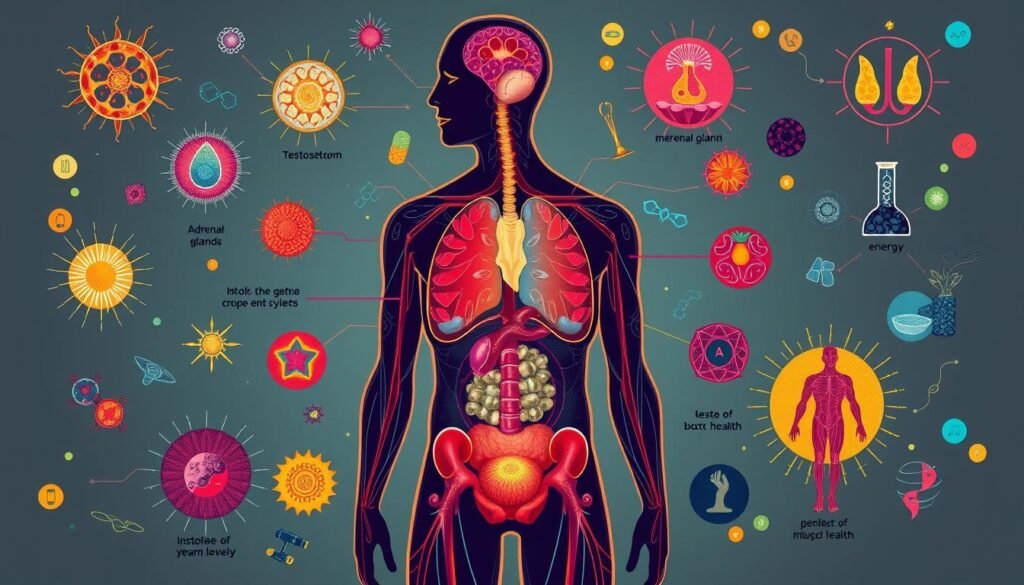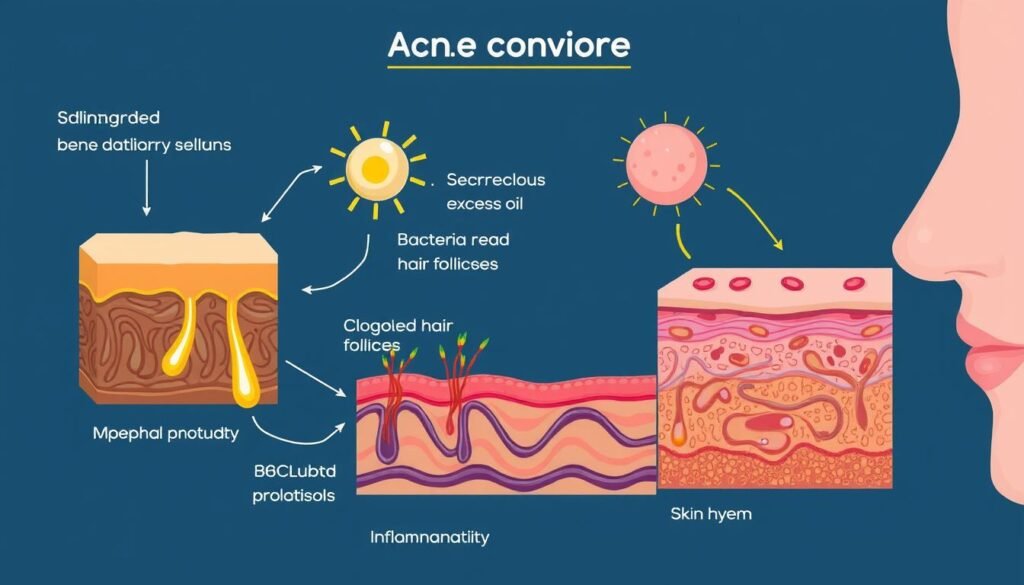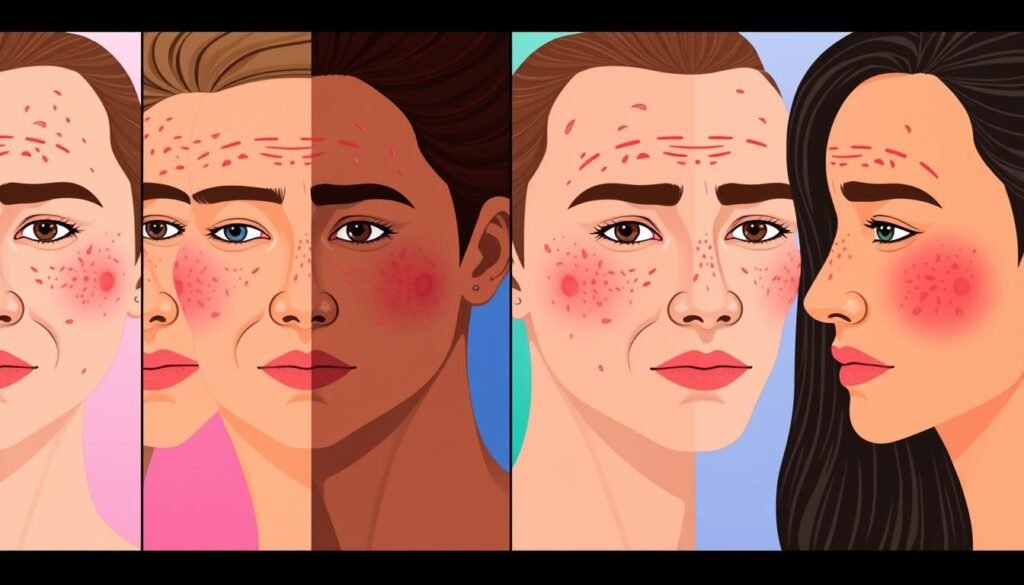Did you know acne vulgaris impacts 80% of young people between 11-30 years old? It’s a common skin problem, not just for teenagers. Many adults, especially women with changing hormone levels, face it too. High testosterone levels might be a big cause of acne. This makes many wonder how the two are linked.
When testosterone levels go up, so does sebum production. This can block pores and lead to acne. This connection is strong during puberty and in conditions like polycystic ovary syndrome. To understand how testosterone affects acne, check out Healthline.
Key Takeaways
- High testosterone levels can increase sebum production, contributing to acne.
- Acne is prevalent in 80% of individuals aged 11-30, often exacerbated by hormonal fluctuations.
- Women with hormonal imbalances, particularly during their menstrual cycle, are more susceptible to acne flare-ups.
- Conditions like polycystic ovary syndrome (PCOS) can significantly affect testosterone levels and acne severity.
- Topical treatments and hormonal therapies can be effective in managing hormonal acne.
Introduction to High Testosterone Levels and Acne
Acne isn’t just a teenage problem; many adults suffer too. High testosterone levels are a big cause, especially in women. This leads to more oil production, blocking pores and setting the stage for hormonal acne.
Testosterone’s role in acne is key. High levels can change skin cells and cause inflammation. This helps testosterone acne develop. Research also shows a link between hormone levels and acne severity. For example, 44% of women see acne worsen before their period.
It’s clear that high testosterone can mean more acne. Studies show acne patients often have different hormone levels than those without acne. For instance, their testosterone might average 3.5 ng/ml. Keeping hormones in balance can help. This might mean changing your lifestyle or getting medical help. For more on this, visit medical literature.
It’s important to understand how testosterone affects skin. This means looking at everything. From puberty changes to the impact of your diet and skin care. It’s vital to know these to manage acne well.
To wrap up, knowing how testosterone and acne are linked is crucial. If you get this, you can find the right treatments. This means a better life for those dealing with acne.
Understanding Testosterone and Its Role in the Body
Testosterone is a key hormone for both men and women, but in different amounts. It’s known as an androgen hormone, important for many body functions. This hormone starts affecting us early and plays a role in our health throughout life. Learning about the functions of testosterone highlights its importance for everyone’s health.
What is Testosterone?
Testosterone is produced mostly in men’s testes and women’s ovaries. Its levels change over our lifetime, impacting many body processes. For example, it starts working in the womb as early as six weeks old. In men, it’s crucial for making reproductive tissues and traits like more muscle and bone. Women need it for their sexual health and overall happiness.
Functions of Testosterone in Men and Women
The functions of testosterone go beyond just reproduction. In men, it keeps up their sex drive, muscle strength, and bone health. For women, it supports their desire, energy, and emotions. Studies show that changes in testosterone levels can affect our minds and bodies, changing our mood and vitality.
| Function | Male Health | Female Health |
|---|---|---|
| Libido | Critical for sexual desire | Influences sexual interest |
| Muscle Strength | Enhances muscle mass | Supports muscle tone |
| Bone Density | Maintains bone strength | Contributes to bone health |
| Mood Regulation | Affects emotional well-being | Influences mental health |

How High Testosterone Levels Contribute to Acne
High testosterone levels play a big role in causing acne. This is because androgens like testosterone increase sebum production. Too much sebum can cause skin problems, including hormonal acne. It’s important to understand this for people dealing with acne.
The Connection Between Androgens and Sebum Production
Testosterone makes the sebaceous glands produce too much sebum. This leads to a perfect environment for bacteria, causing pores to clog. Blocked hair follicles then become a breeding ground for bacteria. This can lead to inflammation and acne.
Acne Development Process Explained
The acne process starts with pores getting clogged by too much sebum and dead skin cells. Here’s how acne forms:
| Stage | Description |
|---|---|
| 1. Excess Sebum Production | Higher testosterone levels make the sebaceous glands produce more oil. |
| 2. Clogged Pores | Too much sebum mixes with dead skin, causing clogged follicles. |
| 3. Bacterial Growth | Clogged pores create a perfect place for bacteria to grow. |
| 4. Inflammation | Our immune system responds to bacteria, causing redness and swelling. |
| 5. Acne Manifestation | Acne comes in forms like whiteheads, blackheads, and cysts. |
High testosterone levels directly cause various acne types. Managing these levels can help reduce acne’s severity.

Hormonal Acne: A Closer Look
Hormonal acne has many shapes and affects both men and women. It’s linked to how much testosterone you have. Knowing the types tied to hormone swings is key.
Types of Hormonal Acne
There are several kinds of hormonal acne, each needing its way of care. Here’s what you might see:
- Whiteheads: These pop up when oil and dead skin block hair holes.
- Blackheads: These are what you get when the blocked part gets dark.
- Pustules: Red, sore spots filled with pus, standing out on the skin.
- Cysts: Big, sore lumps under the skin that can leave scars.
Prevalence of Hormonal Acne in Different Genders
More women than men usually face hormonal acne. Studies say up to 72% of women with acne have more androgens like testosterone. This is often seen during their monthly cycles. Hormonal acne can start in the teen years or after 20. It may last into the 30s or show up around menopause. Knowing these facts helps in finding the right treatment.

| Type of Acne | Description | Common Locations |
|---|---|---|
| Whiteheads | Small bumps clogged with oil and debris. | Face, neck. |
| Blackheads | Open comedones that appear dark due to oxidation. | Nose, forehead. |
| Pustules | Inflamed red bumps with pus. | Lower face, back. |
| Cysts | Deep, painful lumps that can scar. | Jaws, chest, upper arms. |
Factors That Cause Fluctuations in Testosterone Levels
Testosterone is key in acne development, especially at certain times and due to lifestyle choices. Knowing how changes in testosterone affect the skin is important for clear skin and hormonal balance.
Natural Fluctuations During Puberty
Puberty brings a big rise in testosterone, particularly in boys, leading to more sebum and acne. Teenage acne is often a result of this surge. Understanding these hormone shifts is crucial for acne management during these years.
Impact of Lifestyle Choices on Testosterone Levels
Choice in lifestyle can deeply affect testosterone and, thus, acne severity. Poor sleep, high stress, and bad eating can lower testosterone. These factors increase hormonal imbalance and acne. Healthy living, like exercising and eating well, can balance testosterone. This reduces acne risks. To manage acne, it’s important to grasp the influence of lifestyle. Learn how lifestyle can impact acne.
Medical Conditions Linked to High Testosterone Levels
High testosterone levels may suggest some medical conditions, especially in women. They might face acne and more body hair. It’s important to know this to understand hormonal imbalances better.
Polycystic Ovary Syndrome (PCOS) and Its Effects
Polycystic Ovary Syndrome, or PCOS, is closely linked to high testosterone. It affects 8% to 13% of women of reproductive age. Of these, 80% to 90% might have hyperandrogenism.
PCOS can cause consistent acne, a lot of body hair, and irregular periods due to high androgen levels. These hormones can disrupt normal ovulation, impacting skin health.
Other Medical Conditions Contributing to Hormonal Imbalance
There are several conditions that can mess with hormone balance and testosterone. Learning about these can help address acne and other hormonal symptoms:
- Adrenal tumors (benign or cancerous) that may secrete excess androgens.
- Congenital adrenal hyperplasia, affecting adrenal hormone production and possibly leading to hyperandrogenism.
- Cushing syndrome, marked by too much cortisol, which might also alter androgen levels.
- Androgen-secreting tumors, rare but can cause very high testosterone levels.
- Certain medications, like steroids or antiepileptics, can increase testosterone and make hormonal imbalances worse.
Identifying these conditions is key for the right diagnosis and treatment. Each one can cause different signs of hormonal imbalance, including a higher chance of acne.
| Medical Condition | Symptoms | Effects on Testosterone Levels |
|---|---|---|
| Polycystic Ovary Syndrome (PCOS) | Acne, Hirsutism, Irregular periods | Elevated |
| Congenital Adrenal Hyperplasia | Body hair growth, Acne, Irregular cycles | Elevated |
| Cushing Syndrome | Weight gain, Mood swings, Skin issues | Potentially elevated |
| Adrenal Tumors | Hormonal disturbances, Acne | Elevated |
| Androgen-secreting Tumors | Hirsutism, Severe acne | Significantly elevated |
Understanding Sebum Production and Acne
Sebum production and acne development are closely linked in skin health studies. Sebaceous glands create sebum, which keeps our skin moist and elastic. When we have more testosterone, these glands make more sebum, and our skin gets oily. Too much sebum can block hair follicles and cause acne.
Role of Sebaceous Glands in Skin Health
Sebaceous glands are vital for healthy skin. They secrete sebum, our skin’s natural moisturizer. Sebum prevents our skin from losing water and keeps it soft. But, hormonal changes, like puberty or testosterone therapy, can make these glands more active. This can lead to acne.
How Excess Sebum Contributes to Acne Development
Too much sebum, due to high testosterone, can cause acne. It happens when clogged pores trap bacteria and dead skin, causing inflammation. Acne is the top skin issue in the U.S., impacting 50 million people each year. Understanding sebum’s role is key to better skin care and acne treatment.
Treatment Options for Hormonal Acne
When dealing with hormonal acne, there are many treatments to consider. Each person reacts differently, so finding the best option is key. Topical solutions and medicines that balance hormones play a big role. They help in getting clearer skin.
Topical Treatments and Their Effectiveness
Topical treatments are usually the first step in fighting hormonal acne. Products like retinoids and benzoyl peroxide help reduce swelling and stop pores from clogging. They work well for slight acne cases. Topical treatments can show improvement quickly.
But, they might irritate the skin. It’s best to talk to a skin doctor to customize these treatments.
Medications Targeting Hormonal Imbalances
For tough hormonal acne, drugs that fix hormonal imbalances are important. Drugs like spironolactone are given to women to balance hormone levels and cut down oil production. Birth control pills also help by managing periods and lessening acne bursts. These options work well when other treatments don’t, especially for those with PCOS.